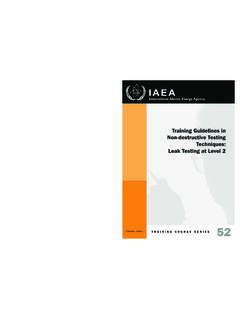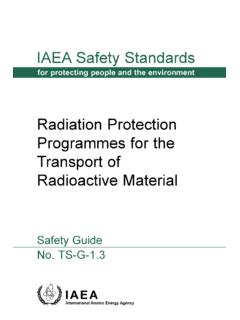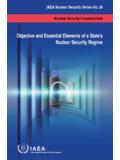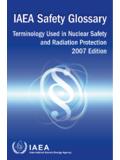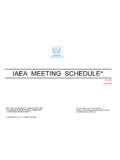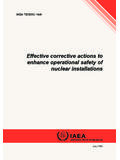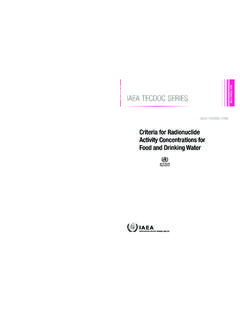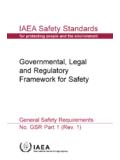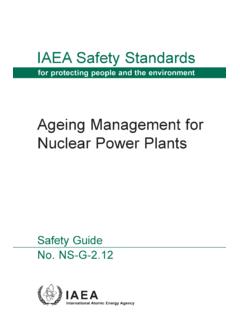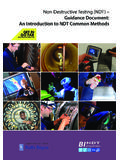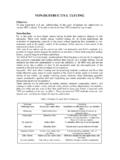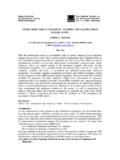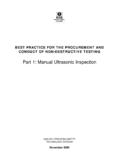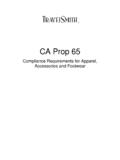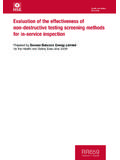Transcription of Guidebook for the Fabrication of Non-Destructive …
1 TRAINING COURSE SERIES No. 13 Guidebook for the Fabrication of Non-Destructive testing (NDT) Test Specimens INTERNATIONAL ATOMIC ENERGY AGENCY, 2001 The originating Section of this publication in the IAEA was: Industrial Applications and Chemistry Section International Atomic Energy Agency Wagramer Strasse 5 Box 100 A-1400 Vienna, Austria Guidebook FOR THE Fabrication OF Non-Destructive testing (NDT) TEST SPECIMENS IAEA, VIENNA, 2001 IAEA-TECDOC-TCS-13 ISSN 1011 4289 IAEA, 2001 Printed by the IAEA in Austria June 2001 FOREWORD The International Atomic Energy Agency (IAEA) is promoting the industrial applications of radiation technology, which include Non-Destructive testing (NDT) under its various programmes such as individual country technical co-operation (TC) projects, regional projects and co-ordinated research projects (CRPs).
2 The NDT technology is essentially needed for the improvement of the quality of industrial products, equipment and plants all over the world, especially in the developing Member States. An important feature of the NDT programme, notably in the East Asia and Pacific (RCA) region, has been the establishment in each of the Member States of a system for training and certification of NDT personnel based on the International Organization for Standardization standard ISO/FDIS 9712-1999, Non-Destructive testing : Qualification and Certification of Personnel . The main focus is the creation of a core group of personnel who are trained and qualified to establish the training and certification process in their respective countries.
3 An important requirement for such a process is to have appropriate training materials that include, among others, NDT test specimens having standard known dimensions and in-laid artificial defects simulating the real defects that can or may occur in industrial components. NDT test specimens constitute a very important part of training and certification of NDT personnel and are important for carrying out actual inspection and testing , and for achieving international harmonization of NDT practices. Naturally, therefore, there is a need to pay greater attention to this subject. A number of seminars and workshops on NDT test specimens have been organized for this purpose during the past years under various RCA regional projects while a number of additional activities, such as regional training courses and seminars, are planned for the future.
4 It has always been felt that there is a strong need to have a proper Guidebook addressing various issues and problems related to the Fabrication of NDT test specimens. Such a book would be useful for conducting training courses on this theme in the future, thereby spreading the know-how for the Fabrication of NDT test specimens and establishing and strengthening education, training and certification process in many Member States on a sustainable basis. In view of the above, the IAEA organized an advisory group of experts to develop a Guidebook for the Fabrication of NDT Test Specimens. The experts consulted the ISO/FDIS 9712-1999 requirements for training and certification of personnel and the suitability of various types of NDT test specimens that are needed to meet such requirements.
5 A set of appropriate NDT test specimens, as well as the methodology and procedures for their Fabrication , were established. These are presented in this Guidebook . The experts recommended that these procedures be taken only as a guide, and can be expanded and perfected by the national certifying bodies of the Member States. It was felt that there is the need to compile similar procedures for the remaining types of test specimens but this could not be addressed due to limited time. The IAEA wishes to express its appreciation to the governments and organizations who provided financial, technical and administrative support, and to the experts who contributed to the production of this Guidebook . The IAEA officer responsible for this publication was Khan of the Division of Physical and Chemical Sciences.
6 EDITORIAL NOTE In preparing this publication for press, staff of the IAEA made up the pages from the original manuscript(s). The views expressed do not necessarily reflect those of the IAEA, the governments of the nominating Member States or the nominating organizations. Throughout the text names of Member States are retained, as they were when the text was compiled. The use of particular designations of countries or territories does not imply any judgement by the publisher, the IAEA, as to the legal status of such countries or territories, of their authorities and institutions or of the delimitation of their boundaries. The mention of names of specific companies or products (whether or not indicated as registered) does not imply any intention to infringe proprietary rights, nor should it be construed as an endorsement or recommendation on the part of the IAEA.
7 CONTENTS 1. Non-Destructive testing : BASIC OVERVIEW OF COMMON METHODS ..1 Introduction ..1 Common NDT methods ..2 Visual inspection ..2 Liquid penetrant inspection ..3 Magnetic particle Radiographic inspection ..6 Ultrasonic testing ..8 Eddy current testing ..10 2. TECHNOLOGY OF WELDING ..11 General considerations ..11 Weld designs and Welding processes Basic overview of common methods ..15 Manual metal arc welding ..15 Gas metal arc welding ..16 Flux cored arc welding ..18 Submerged arc welding ..20 Gas tungsten arc 3. WELD DEFECTS AND DISCONTINUITIES ..27 General considerations ..27 Quality assurance ..28 Quality assurance system ..28 NDT flaw characteristics ..28 Evidence/trials.
8 28 4. EXAMINATION TEST SPECIMEN REQUIREMENTS ..29 Geometric conditions ..29 Surface condition and Dimensional tolerances ..29 Selection of raw materials prior to the Fabrication of test Welding requirements ..29 General Approval of welding technicians ..29 Welding procedures ..30 Weld Post weld heat Inspection requirements ..30 General Visual inspection ..30 Non-Destructive evaluation ..30 5. FLAW Introduction ..32 Tolerances for intended flaws ..32 Flaw size/location 6. OTHER IMPORTANT Documentation ..34 Security and confidentiality ..34 General design considerations and flaw content of test specimens ..34 Acceptance criteria for unintended flaws in test specimens.
9 34 Rejectable Sensitivity settings, sizing techniques and flaw reporting criteria for ultrasonic test specimens ..35 Information to be supplied by the end user to the Inter-changeability of test specimens between different NDT methods ..36 7. MANUFACTURE OF TEST SPECIMENS ..37 General considerations ..37 Porosity ..37 Pipe or wormholes ..38 Non-metallic inclusions ..38 Surface breaking inclusions ..38 Inclusions for RT ..39 Inclusions for UT ..39 Tungsten inclusions ..39 Lack of fusion ..39 Incomplete root penetration ..40 Cracks ..40 Transverse Underbead Longitudinal cracks ..41 Crater cracks ..42 Hat cracks ..43 Toe and root Concavity at the root or surface of the weld.
10 43 Root concavity ..44 Surface Excessive Lamellar tearing ..45 Burn-through ..46 Root pass Arc-strike ..46 Spatter ..47 Irregular Miscellaneous surface imperfections ..47 Lamination ..47 8. NDT METHOD-RELATED TEST SPECIMENS ..48 Test specimens for liquid penetrant Design and material type(s) of test specimen ..48 Typical flaws ..48 Test specimens for magnetic particle testing ..48 Typical design of test Typical flaws ..48 Test specimens for radiographic Typical design of test Typical flaws ..49 Test specimens for ultrasonic testing ..49 Typical design of test Typical flaws ..50 Test specimens for visual testing ..50 Typical design of test Typical flaws.
